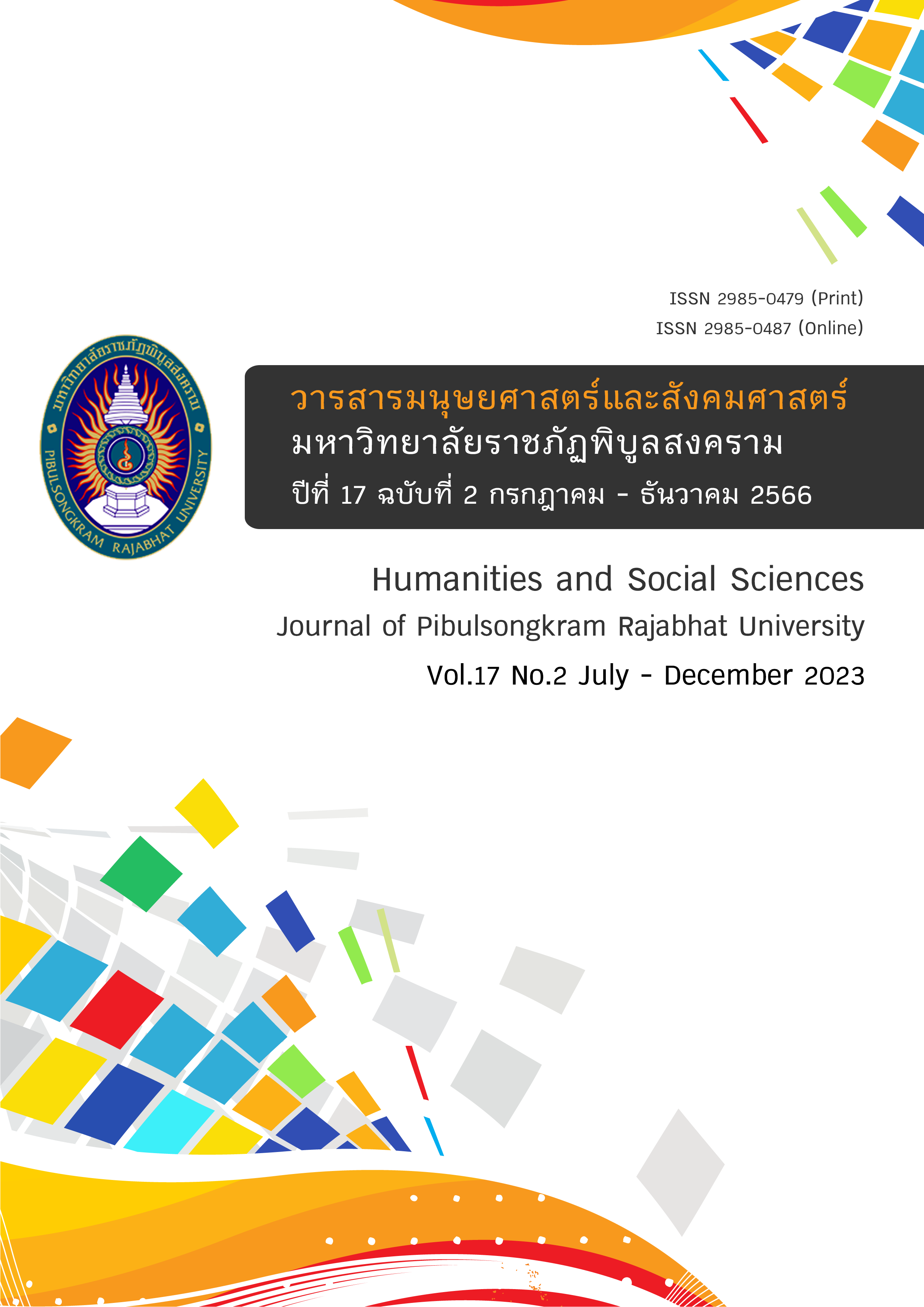A Confirmation Factor Analysis of the Life Skills of Underprivileged Children in the Welfare Schools under the Office of Special Education Administration
DOI:
https://doi.org/10.14456/psruhss.2023.47Keywords:
Life skills, Underprivileged children, WelfareAbstract
The objective of this research was to conduct the confirmatory factor analysis of life skills of underprivileged children in the welfare school under the Special Education Bureau. The subjects of this research were 520 underprivileged children (extremely poor children) in Grade 9 in the first semester, academic year 2020 in the welfare schools under Special Education Bureau, obtained by multi-stage random sampling. The data were collected by using a life skill assessment scale developed by the researcher based on the Life Skills Assessment Scale of the Office of the Basic Education Commission. The instrument’s reliability was .951. The data were analyzed by using basic statistics (frequency and percentage) and confirmatory factor analysis. The results of this research indicated that life skills of underprivileged children in the welfare schools under the Special Education Bureau consisted of four components, namely, self-awareness and self-esteem, critical thinking, decision-making and creative problem-solving skills, emotional and stress management skills, and building good relationships with others. Furthermore, there were a total of 27 indicators, and life skills of underprivileged children in the welfare schools under the Special Education Bureau model has shown that the model conformed to empirical data. As Chi-square test has a value of X2 = 504.38, df. = 263, CFI = 0.963, TLI = 0.950 and RMSEA = 0.041. This means the indicators are suitable for life skills of underprivileged children model found that all the standardized factor weights of 27 indicators were positive ranging from 0.534 - 0.761, reliability in the rang 0.285 – 0.579. Finally the standardized factor weights of second order for the 4 life skills indicators in the ranging 0.816 – 0.939.
References
กรมสุขภาพจิต กระทรวงสาธารณสุข. (2543). คู่มือการสอนทักษะชีวิตเพื่อป้องกันสารเสพติดในสถานศึกษาระดับประถมศึกษา. กรุงเทพฯ: โรงพิมพ์องค์การรับส่งสินค้าและพัสดุภัณฑ์ (ร.ส.พ.).
ชีวรัตน์ ดุษณีย์. (2546). การศึกษาสาเหตุการออกกลางคันสำหรับนักเรียนในสถานสงเคราะห์เด็กบ้านเด็กเมอร์ซี่ ในความดูแลของมูลนิธิส่งเสริมการพัฒนาบุคคล. กรุงเทพฯ: สถาบันราชภัฏจันทรเกษม.
วราพร เอราวรรณ์. (2554). การวิเคราะห์พหุลักษณะ-พหุวิธี 2 ระดับ: หลักการและการประยุกต์. วารสารวิธีวิทยาการวิจัย, 24(3), 393-408.
วิจารณ์ พานิช. (2555). วิถีสร้างการเรียนรู้เพื่อศิษย์ในศตวรรษที่ 21. กรุงเทพฯ: มูลนิธิสดศรี- สฤษดิ์วงศ์.
ศรีหะริ รวินทรนาถ และองค์กร Dream a Dream. (2564). สร้างทักษะชีวิต ประเมินเด็ก และเปลี่ยนแปลงการศึกษา. สืบค้น 2 กุมภาพันธ์ 2564, จาก https://www.eef.or.th/life-skill-assessment-scale-india/.
ศรีหะริ รวินทรนาถ. (2564). ความท้าทายด้านการศึกษาในกลุ่มเด็กด้อยโอกาส. สืบค้น 2 กุมภาพันธ์ 2564, จาก https://www.the101.world/happiness-curriculum/
ศศิวิมล เกลียวทอง. (2556). ปัจจัยบางประการที่ส่งผลต่อทักษะชีวิตของนักเรียนชั้นมัธยมศึกษาปีที่ 5 สำนักงานเขตพื้นที่การศึกษามัธยมศึกษา เขต 2. วารสารวิชาการ Veridian E-Journal, 6(3), 443-460.
สำนักงานคณะกรรมการการศึกษาขั้นพื้นฐาน. (2554). หลักสูตรแกนกลางการศึกษาขั้นพื้นฐาน พุทธศักราช 2551. กรุงเทพฯ: ชุมนุมสหกรณ์.
สำนักงานคณะกรรมการการศึกษาขั้นพื้นฐาน. (2559). แนวทางการพัฒนาทักษะชีวิตบูรณาการ 8 กลุ่มสาระการเรียนรู้ ตามหลักสูตรแกนกลางการศึกษาขั้นพื้นฐาน พุทธศักราช 2551. กรุงเทพฯ: ชุมนุมสหกรณ์.
สำนักงานคณะกรรมการพัฒนาการเศรษฐกิจและสังคมแห่งชาติ. (2560). แผนพัฒนาเศรษฐกิจและสังคมแห่งชาติ ฉบับที่ 12 (2560-2564). กรุงเทพฯ: สำนักงานสภาพัฒนาการเศรษฐกิจและสังคมแห่งชาติ.
สำนักบริหารงานการศึกษาพิเศษ. (2562). แนวทางการจัดกิจกรรมทักษะการดำรงชีวิต ตามกรอบสาระการเรียนรู้ท้องถิ่น ของโรงเรียนศึกษาสงเคราะห์และราชประชานุเคราะห์. กรุงเทพฯ: สำนักบริหารงานการศึกษาพิเศษ.
อนันต์ อุ่นแก้ว. (2556). คู่มือการจัดกิจกรรมเพื่อพัฒนาเด็กด้อยโอกาส. อุบลราชธานี: โรงพยาบาลพระศรีมหาโพธิ์ กรมสุขภาพจิต กระทรวงสาธารณสุข.
อัจศรา ประเสริฐสิน. (2555). การวิจัยและพัฒนาความยึดมั่นผูกพันกับการวิจัยของครูโดยใช้เทคนิค การเสริมพลัง. กรุงเทพฯ: จุฬาลงกรณ์มหาวิทยาลัย.
Nelson-Jones, R. (1997). Life Skills Helping : A Textbook of Practical Counseling and Helping Skills (3rd ed.). Sydney : Holt, Rinehart.
Schumacker, R. E., & Lomax, R. G. (2010). A Beginnerrs Guide to Structural Equation Modeling: SEM. New Jersey: Lawrence Erlbaum Associates.
Downloads
Published
How to Cite
Issue
Section
License
Copyright (c) 2023 Humanities and Social Sciences Journal of Pibulsongkram Rajabhat University

This work is licensed under a Creative Commons Attribution-NonCommercial-NoDerivatives 4.0 International License.
Any articles or comments appearing in the Journal of Humanities and Social Sciences, Rajabhat Phibulsongkram University, are the intellectual property of the authors, and do not necessarily reflect the views of the editorial board. Published articles are copyrighted by the Journal of Humanities and Social Sciences, Rajabhat Phibulsongkram University.









